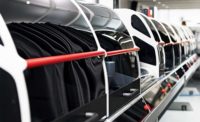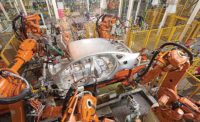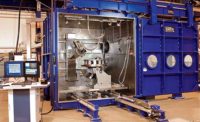Like many machine builders, Fori Automation Inc. faces the daily challenge of building automation equipment that is competitively priced and meets its global customers’ varied design requirements. These requirements often include a unique control platform, process traceability or scalability for future expansion.
Founded in 1984 in Shelby Township, MI, Fori designs and integrates state-of-the art automated systems for the automotive, aerospace and defense industries. It has built systems for assembling tires, wheels, motors, transmissions and headlamp aimers; and installing carpet, glass, doors, seats and cockpits.
One of Fori’s most recent projects involved building a modular assembly line for complex front and rear automotive components. The customer wanted a line with standard controls architecture, along with the capability to handle the company’s choice of platforms and networks.
The line consists of 30 workstations that may or may not be used, depending on the component being assembled. Assembly begins by placing a component frame on a pallet, which has an RFID tag containing process and traceability data.
The line consists of several 30- to 40-foot-long modular sections, each of which features a master I/O distributor with IO-Link interface. Made by Balluff Inc., the distributor is fieldbus independent and vendor neutral. It carries a digital signal over pin 4 of a standard cable and provides 24-volt power to a connected device in a standard configuration.
Garry Hagar, controls engineering supervisor at Fori Automation, says the distributors allow the use of a small control cabinet that only needs to house controllers, network switches, power supplies and safety relays. They also enable Fori to use standard M12 cables for sensors rather than special heavy cables and complex long wiring.
At each workstation, an antenna reads the tag to get work instructions for the assembler and configuration settings for tools and other assembly equipment. A worker then either mounts subassemblies onto the frame or performs some other manual assembly operation. Intelligent software and LED stack lights provide instant process feedback to ensure error-free assembly and maintain traceability throughout production. For example, at one station, bolts are fastened to torque limits specified on the tag.
According to Hagar, the distributors have saved Fori about 30 percent in labor and time related to building panels and wiring components far away from the panels. Workers now use quick disconnects to easily remove power, air and a network cable from each section’s main panel. Reassembly of each section at the customer’s factory is also done quickly.
The distributors’ built-in scalability allows future expansion or additional I/O points without the need for additional network nodes. For example, a distributor with eight IO-Link ports hosts up to 136 configurable inputs or outputs. Without the ports, Hagar says Fori would need up to nine network nodes to obtain the same amount of I/O points.
The distributors also ease connectivity and configuration of smart devices (such as RFID read-write heads and inductive couplers) directly through a PLC. All configuration data is stored on the PLC in case any device needs to be replaced. Add-on instructions and function blocks quicken programming.
“Standardization of equipment and controls cuts our engineering time by 50 percent,” notes Hagar.
A master distributor also facilitates troubleshooting. That’s no small thing, since unplanned downtime is costly in automotive assembly lines. “[For us] the ability to quickly troubleshoot is only possible with modular systems,” says Hagar.
For more information on I/O distributors, call 800-543-8390 or visit www.balluff.us.




